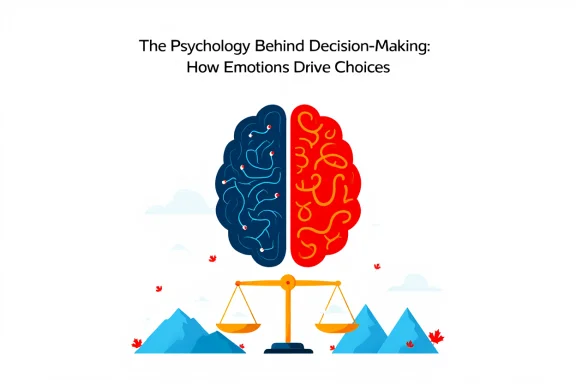The Psychology Behind Decision-Making: How Emotions Drive Choices

Introduction: When Feelings Take the Wheel
Picture this: You’re standing in a Tim Hortons, staring at the menu board. Logic says get the medium coffee — it’s the best value. But something tugs at you toward that maple cream donut, even though you promised yourself you’d eat healthier. Sound familiar?
That’s your emotions hijacking your decision-making process, and it happens way more often than most Canadians realize. Whether you’re a facility manager choosing new booking software, a hockey parent deciding on equipment, or a business owner setting prices, emotions are quietly pulling the strings behind every choice you make.
Understanding the psychology behind decision-making isn’t just academic fluff — it’s the difference between choices that serve you well and ones that leave you saying «sorry» to your future self.
How Emotions Actually Drive Our Choices
The Limbic System: Your Brain’s Overeager Helper
Deep in your brain sits the limbic system — think of it as that friend who means well but sometimes gives terrible advice. This emotional processing center developed long before humans worried about RRSP contributions or choosing the right internet provider. It’s designed for survival, not spreadsheets.
When you’re making decisions, your limbic system processes information about 20 times faster than your rational brain. That’s why you might feel drawn to one sports facility booking system before you’ve even read the features list. Your emotions are already voting.
The Canadian Context: Cultural Influences on Decision-Making
Canadian decision-making carries unique cultural fingerprints. Our tendency to avoid conflict means we might choose the «safe» option even when a bolder choice serves us better. The infamous Canadian politeness can lead facility managers to stick with underperforming vendors rather than have difficult conversations about switching systems.
Statistics Canada research shows that Canadian consumers take 23% longer to make major purchasing decisions compared to our American neighbors — often because we’re trying to balance emotional comfort with rational analysis.
Common Emotional Biases That Trip Up Canadians
The Status Quo Bias: «If It Ain’t Broke, Don’t Fix It»
Canadians love stability — just look at how long we’ve been using the same $5 bill design. This preference shows up in business decisions too. Sports facility managers often stick with outdated reservation systems simply because change feels risky, even when new technology could boost revenue by 30% or more.
Loss Aversion: Fear of Missing Out (or Losing What We Have)
Research from the University of Toronto shows that Canadians feel losses twice as strongly as equivalent gains. In practical terms, a recreational center director might avoid upgrading their booking platform because they’re more worried about temporary disruption than excited about long-term benefits.
Social Proof: Following the Crowd from Coast to Coast
When Alberta recreation centers started adopting mobile-first booking systems, facilities across Western Canada quickly followed suit. We look to our peers for validation — sometimes missing opportunities to lead rather than follow.
Proven Strategies to Make More Rational Decisions
The 10-10-10 Rule: A Canadian Twist
Before making important choices, ask yourself: «How will I feel about this decision in 10 minutes, 10 months, and 10 years?» This technique, popularized by Canadian productivity expert Julie Morgenstern, helps separate temporary emotions from lasting consequences.
For facility managers, this might mean choosing booking software based on long-term scalability rather than immediate ease of implementation.
The Pre-Mortem Method
Imagine your decision fails spectacularly. What went wrong? This exercise, developed at the Rotman School of Management in Toronto, helps identify emotional blind spots before they cause problems.
Create Decision Frameworks
Establish criteria before emotions enter the picture. If you’re evaluating sports facility management platforms, list your must-haves, nice-to-haves, and deal-breakers before demos begin. When every vendor’s sales pitch triggers your excitement, you’ll have objective guidelines to fall back on.
The Role of Stress in Canadian Decision-Making
Winter Blues and Choice Paralysis
Seasonal Affective Disorder affects up to 15% of Canadians, and it impacts decision-making ability. During darker months, we tend toward more conservative choices and delay major decisions. Smart facility managers plan major technology rollouts for spring when staff energy and optimism naturally increase.
The Hockey Parent Phenomenon
Anyone who’s watched minor hockey understands how stress warps judgment. Parents make equipment purchases based on fear («What if they get hurt?») rather than logic («Do they really need $500 skates at age 8?»). The same emotional triggers affect business decisions — urgency and fear often lead to poor choices.
Building Emotional Intelligence in Professional Settings
The Pause Principle
Train yourself to pause before major decisions. Count to ten, take three deep breaths, or step outside for fresh air (yes, even in February). This simple delay allows your rational brain to catch up with your emotional response.
Seek Diverse Perspectives
Canadians excel at collaboration — use it. Before committing to significant facility upgrades or system changes, gather input from staff, members, and industry peers. Different viewpoints help identify emotional biases you might miss on your own.
Document Your Decision Process
Keep records of why you made certain choices. Six months later, when evaluating results, you’ll better understand which factors were rational and which were emotional. This creates a feedback loop that improves future decisions.
Conclusion: Making Peace with Emotional Decision-Making
Perfect rational decision-making is impossible — and honestly, it would make life pretty boring. Emotions provide valuable information about what matters to us. The goal isn’t to eliminate feelings from choices but to recognize when they’re helpful versus when they’re leading us astray.
Whether you’re choosing facility management software, setting membership prices, or deciding on seasonal programming, understanding the psychology behind your choices gives you a massive advantage. You’ll make decisions that align with both your heart and your head — a very Canadian approach to problem-solving.
Ready to put these insights into practice? Start by identifying one important decision you’re currently facing and apply the 10-10-10 rule. You might be surprised by what you discover about your own decision-making patterns.